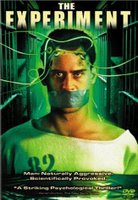das experiment & prison torture
 I happened to rent Das Experiment, the fictionalized movie version of the famous Stanford prison experiment, just as more photos of torture and abuse by U.S. forces at Iraq's Abu Ghraib prison have come out.
I happened to rent Das Experiment, the fictionalized movie version of the famous Stanford prison experiment, just as more photos of torture and abuse by U.S. forces at Iraq's Abu Ghraib prison have come out.In psychologist Philip Zimbardo's experiment, Stanford students were randomly assigned be a "guard" or a "prisoner." Though Das Experiment starts with a disclaimer that all the characters and events are completely fictional, it is remarkably true to the events in the experiment.
The student guards actually did strip the prisoners naked, force them to clean toilets with their bare hands, do push ups as punishment, pit the prisoners against each other, and try to foil an escape plan. Even Zimbardo got caught up in it, acting less like a researcher and more like a prison warden, he writes on the on the official Stanford prison experiment site.
He also writes there:
What happens when you put good people in an evil place? Does humanity win over evil, or does evil triumph? These are some of the questions we posed in this dramatic simulation of prison life conducted in the summer of 1971 at Stanford University....
Our planned two-week investigation into the psychology of prison life had to be ended prematurely after only six days because of what the situation was doing to the college students who participated. In only a few days, our guards became sadistic and our prisoners became depressed and showed signs of extreme stress.
 The site has an excellent slide show with videos detailing the experiment, which Zimbardo says parallels the Abu Ghraib abuses.
The site has an excellent slide show with videos detailing the experiment, which Zimbardo says parallels the Abu Ghraib abuses.In the New Yorker, Seymour Hersh, who has investigated deep into the abuses, asks how far up does the responsibility go? Hersh talked to people who said that the abuse was clearly intended by higher ranking military intellgence, and that the soldiers were following orders to abuse.
The Bush administration, on the other hand, clearly wants the abuses to appear as isolated events by soldiers who got out of line in their prison guard role—basically, that they became like the students in the Stanford prison experiment. CBS reports:
Defense Secretary Donald H. Rumsfeld, testifying Thursday on Capitol Hill, said the soldiers responsible for the Abu Ghraib abuses have been "punished for the behavior that was unacceptable."But as Salon.com notes in a long article featuring many photos not publicly seen before:
It is noteworthy that some of the CID [the Army's Criminal Investigation Command] documents refer to CIA personnel as interrogators of prisoners at Abu Ghraib. But no CIA officers have been prosecuted for any crimes that occurred within the prison, despite the death of at least one Iraqi during a CIA interrogation there.It seems clear we haven't seen the end of this, and that more people were involved than the few who have been prosecuted so far.
And as Zimbardo noted in a recent talk, an earlier study by psychologist Stanley Milgram may shed more light on the Iraq prison abuse:
Zimbardo said the Milgram study, which found that 65 percent of ordinary residents of New Haven, Conn., were willing to give apparently harmful electric shocks of up to 450 volts to a protesting victim so long as a person in authority commanded them to, is a lesson in how an ideology of doing public good can be used to create evil.Such findings have been backed up by more recent studies as well.
So what percentage of the public is willing to go along with the Bush administration when it says the problem was a few bad apples, and it's been taken care of?












0 Comments:
Post a Comment
<< Home